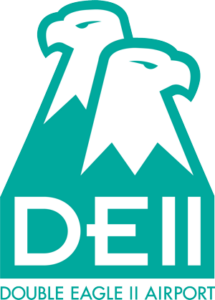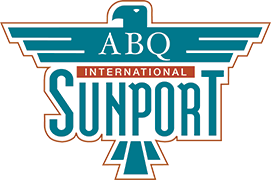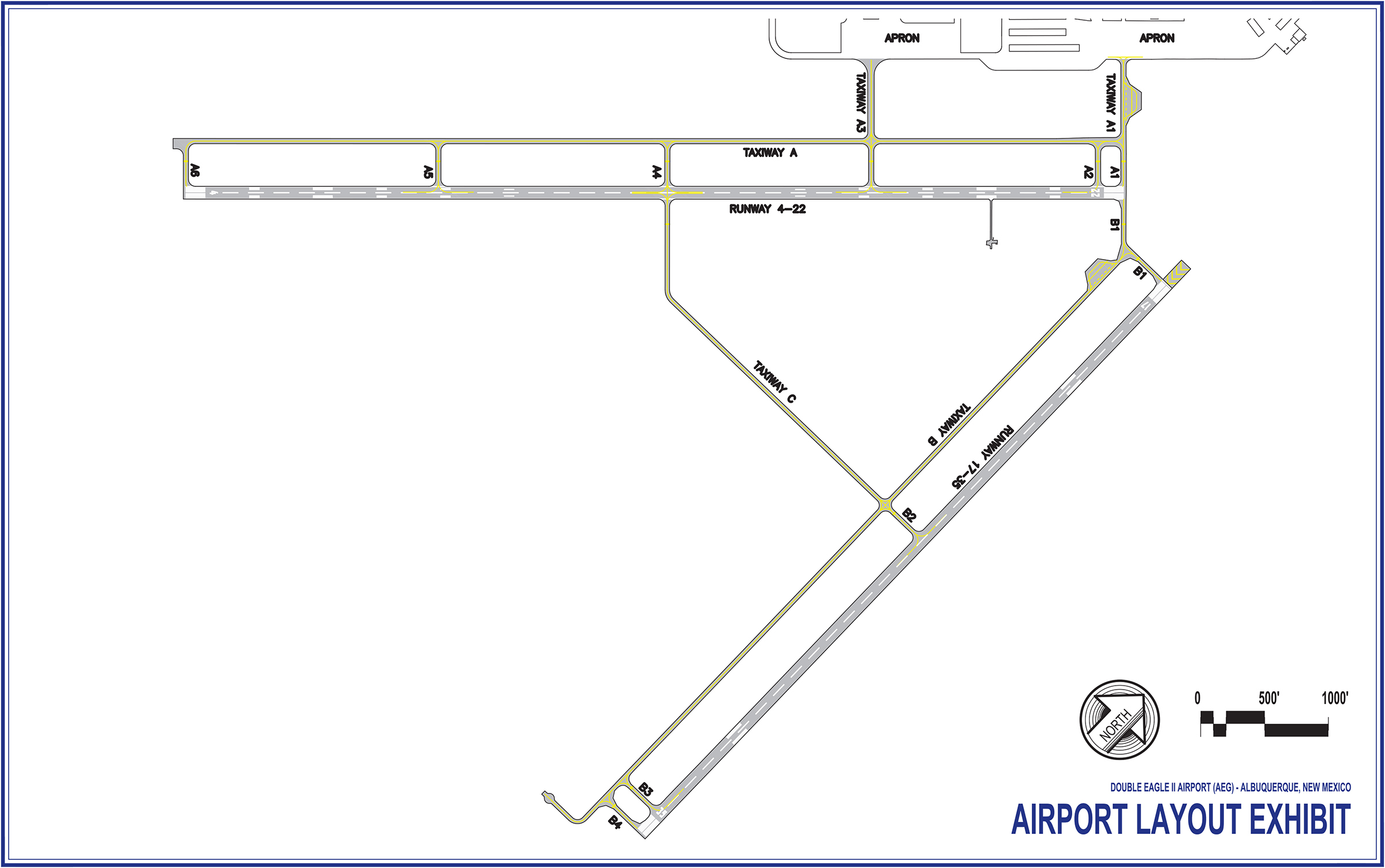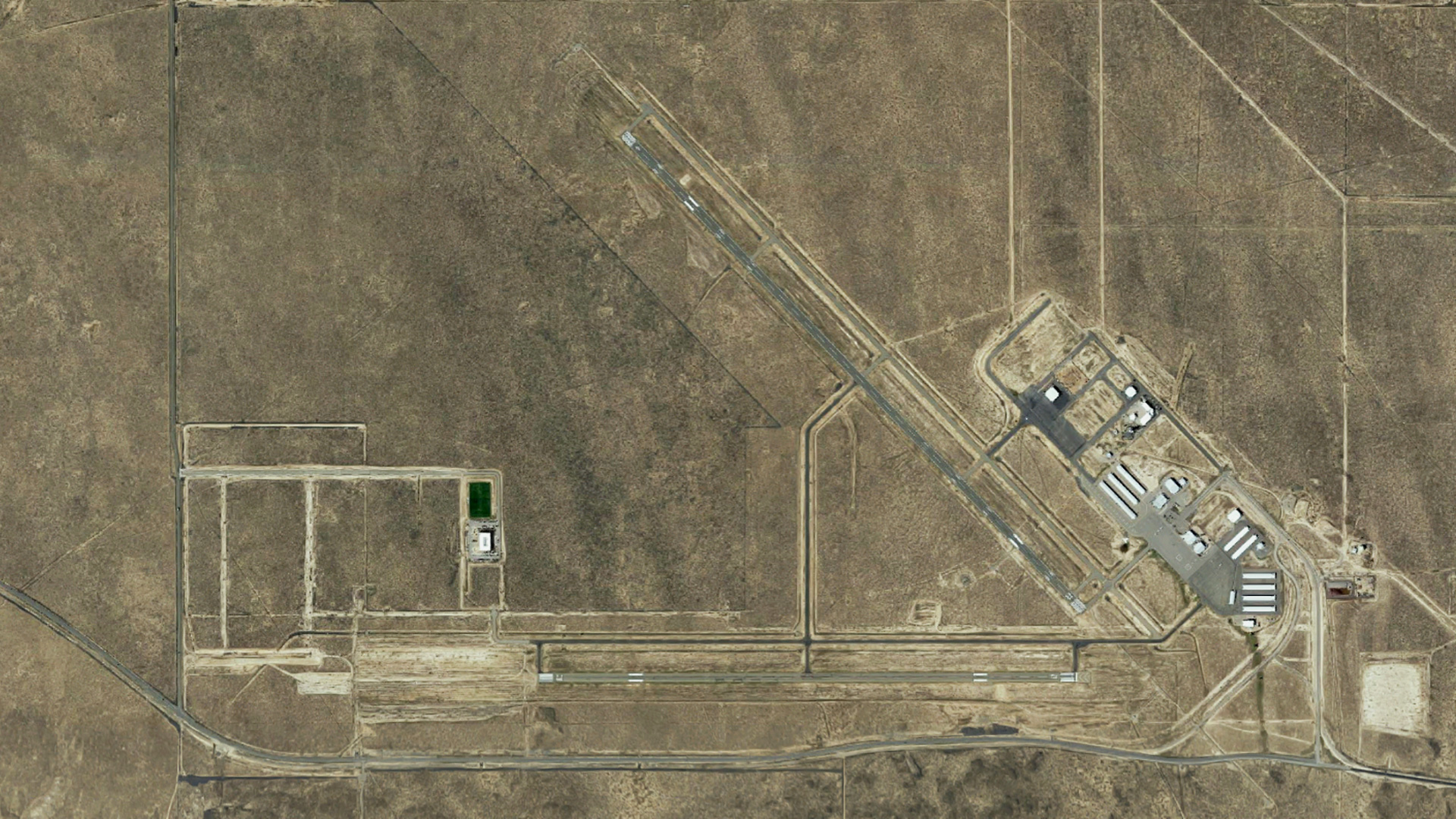Double Eagle II Airport
important notification !
Double Eagle II runway 17-35 will be closed for rehabilitation April 22, 2024 – October 1, 2024
double eagle II airport
Double Eagle II Airport (AEG) is an active general aviation facility on Albuquerque’s west side. There are approximately 240 based aircraft and 120,000 annual operations comprising training, military, air ambulance, charter, private and corporate flights. The airport sits at an elevation of 5,834 feet above sea level and is located approximately eight miles north of Interstate 40 at the top of Nine Mile Hill on Albuquerque’s West Mesa.

airport facilities
- Runway 4-22 is 7,398 feet in length by 100 feet wide, has full ILS, and is equipped with a MALSR on the runway 22 end.
- Runway 17-35 is 5,999 feet in length by 100 feet wide and has REIL on each end.
- Runway 4 and 17 are equipped with PAPI visual navigational aide.
- Traffic pattern altitude is 6,800 feet mean sea level.
- There are right-hand traffic patterns for runways 22 and 35.
uber & lyft driver drop-off locations

Main Gate

Bode Pedestrian Entrance/Gate

Mid-Field Gate
resources for local pilots
airport management
Airport management is provided by the City of Albuquerque’s Aviation Department
BRIAN BOYD
Deputy Director, Operations
505.328.8708
bboyd@cabq.gov
blank
environmental documentation
Download PDFs related to environmental studies for Double Eagle II’s proposed projects.
Double Eagle II Airport Access Road B Environmental Assessment
Double Eagle II FONSI/ROD
Double Eagle II Final EA Chapters 1-2
Double Eagle II Final EA Chapters 3-4
Double Eagle II Final EA Appendices A-B
Double Eagle II Final EA Appendix C
Double Eagle II Final EA Appendices D-H
Double Eagle II Final EA Appendix I
Double Eagle II Final EA Appendices J-K
Double Eagle II Final EA Appendix L
Double Eagle II Final EA Appendix M
sustainability
The City of Albuquerque is committed to sustainability and green building practices. The new airfield maintenance facility at Double Eagle II was awarded LEED Gold certification in 2011 for its achievements in sustainability. It was the City’s first Green Path Program public project. The Green Path Program encourages, and facilitates, voluntary design and construction of energy efficient buildings that substantially exceed code minimum. Only the most energy efficient buildings meet Green Path criteria.
LEED Certification
The United States Green Building Council (USGBC) was founded in 1993 as a non-profit, consensus based committee organization with a mission to transform the building industry into sustainability. The USGBC’s core purpose is to transform the way buildings and communities are designed, built and operated, enabling a socially responsible, healthy and prosperous environment that improves the quality of life. The USGBC is also the administrator of the Leadership in Energy and Environmental Design (LEED) Rating System, which started in 1999.
The LEED Rating System was developed as a format for benchmarking what can be constituted as “green building”. LEED addresses sustainable design criteria under six main categories: (1) sustainable sites, (2) water efficiency, (3) energy and atmosphere, (4) materials and resources, (5) indoor environmental quality, and (6) innovation in design.
The airfield maintenance facility achieved 47 points overall, in the following categories:
Sustainable Sites
- SSc4.2: Alternative Transportation for Bikes—Double Eagle has provided a bike rack and showering facility giving occupants an opportunity to commute to work via bike.
- SSc4.3/4.4: Alternative Transportation for Low Emitting and Fuel Efficient Vehicles, Parking Capacity—Double Eagle has set aside preferred parking for low emitting and fuel efficient vehicles and for carpool with the intent of promoting conscientious transportation to this facility and reduce the carbon footprint of building occupants.
- SSc5.1 & 5.2 Protect or Restore Habitat/Open Space—Double Eagle has set aside land as open space and vegetated the land with native vegetation. This in turn, helps reduce the need for water as this native vegetation already responds to the typical waterfall in its native landscape.
- SSc6.1/6.2: Stormwater Design—This project reduces water pollution by reducing the contaminants leaving the site and removing pollutants from stormwater runoff. All stormwater leaving the Double Eagle site will flow through 4 major retention ponds that allow the water to be naturally treated and stored to avoid unhealthy runoff to streams in large storm events.
Water Efficiency
- WEc1: Water Efficiency—The landscape design of native vegetation includes mainly drought tolerant plants and will not require the use of potable water.
WEc3: Water Use Reduction—Use of dual-flush toilets, low flow urinals, and aerators on faucets contributes to an overall water savings of 38% over the standard water fixtures used in a similar building per ASHRAE 90.1-2004
Energy and Atmosphere
- EAc4: Enhanced Refrigerant Management—Ozone (O3), a naturally-formed gas, is an atmospheric layer that regulates UV radiation that reached Earth from the sun. Chlorofluorocarbons (CFCs) release chlorine atoms near the ozone and convert them to O2, reducing the ozone later. Double Eagle uses no CFCs and reduce other harmful ozone depleting compounds in all refrigeration used in the cooling equipment for the buildings heating, ventilation, air conditioning and refrigeration systems.
- EAc6: Green Power—Double Eagle will purchase 35% (or 70% for an ID credit depending on owner decision) green power. This green power purchase encouraged the development and use of grid-source renewable energy technologies.
Materials and Resources
MRc2: Construction Waste Management—Over 50% OR 75% of the construction waste from Double Eagle was diverted from the landfill and recycled. This includes scrap metal, plastics, paper, cardboard, and other building materials.
MRc4: Recycled Content—Over 20% of the building materials used to build Double Eagle were made of post-consumer o post-industrial recycled content reducing the impact resulting from extraction and processing of virgin materials.
MRc5: Local and Regional Materials—Over 20% of building materials used on Double Eagle were extracted, processed, and manufactured regionally within 500 miles of the site. This supports local economies and encourages the use of indigenous resources reducing environmental impacts from transportation.
Indoor Environmental Quality
- EQc4: Low Emitting Materials—Odorous, irritating and harmful air contaminants have been reduced in the building by using low volatile organic compounds for all adhesives, sealants, paint, and coatings and utilizing only green label plus carpet and composite wood free of urea-formaldehyde. The reduction of these harmful contaminants creates a healthy environment for occupants.
- EQc8.1 and 8.2: Views for 90% of Spaces—Core and shell building design is such that tenants will have views from 90% of spaces and over 50% of the spaces are daylight to a ambient level equal to typical fixtures
Green Cleaning Program
- Double Eagle will implement a green cleaning program that utilizes strategies to reduce harmful chemical infiltration through cleaning creating a healthier environment for both cleaning crews and occupants.
history
The Double Eagle II Airport (DEII) genesis dates back to 1969 when a study by Landrum & Brown examined a means of accommodating aviation growth in the Albuquerque area. In 1970 the City and County appointed a joint Metropolitan Airport Evaluation Committee to study the need for facilities. The group, which received support services from the Middle Rio Grande Council of Governments, was later renamed the Metropolitan Airport Development Committee.
In 1972, the State of New Mexico commissioned a study to prepare a state airport system plan. That plan identified an urgent need for additional general aviation facilities in the Albuquerque area. FAA grant money was received toward the development of a reliever airport master plan.
In 1974, the Council of Governments formed the West Mesa Air Facility Land Acquisition Task Force and sought out federal funding for land acquisition. Public hearings produced considerable controversy over the need for a new airport, but it was eventually approved.
Construction began in 1982, and the airport was named after the Double Eagle II balloon, the first balloon to cross the Atlantic Ocean, piloted by Ben Abruzzo, Maxie Anderson, and Larry Newman. DEII opened in 1983 with one runway, 4-22. The second runway, 17-35, was added several years later. The control tower wasn’t added til about the mid 2000’s, using an old cab from the Albuquerque International Sunport.
master plan
In 1975 the Urban Transportation Planning Board of the Council of Governments recommended that local governments proceed with the application process for federal assistance in the construction of a new airport. The next step was a year-long environmental impact assessment, which was completed in December 1976. Public hearings were held in early 1977. An initial FAA grant provided funding for land acquisition and was accepted by the City in the fall of 1978. A second grant for land acquisition followed in 1979.The Bond Ranch property was acquired on April 2, 1981. The City Council applied to the FAA for the first of several construction grants. Final planning and design commenced and ground was broken for the airport on December 10, 1982.
Master Plan Document
Double Eagle II Master Plan
comments and questions form
services
- Automated weather observation information is available continuously on 119.025 MHz, or via telephone at (505) 842-2009.
- Tower hours of operation are 6 am to 10 pm seven days a week.
- Frequencies:
Tower 120.15 MHz
Ground control 121.625 mhz
AWOS and ATIS 119.025
- Frequencies:
fixed based operators
-
Bode Aero Services
Offers 24-hour service. Self serves or full-serve av-gas is available as is full-service Jet -A fuel. Tie-downs, hangars, and catering service as well as rental cars are available upon request. Maintenance and avionics with Bode Aviation on site.
(505) 352-0292
Toll-free: (877) 384-981
www.flybode.com/fbo -
Bode Aviation
Offers flight training, aircraft rental, airframe and powerplant repair, avionics service, and charter service.
(505) 884-4530
Toll-free: (888) 884-4530
www.flybode.com
doing business
For information about doing business with or at Double Eagle II Airport, contact the City of Albuquerque’s Aviation Department
MANNY MANRIQUEZ
Deputy Director,
Innovation & Commercial Development
505.916.4341
mmanriquez@cabq.gov




